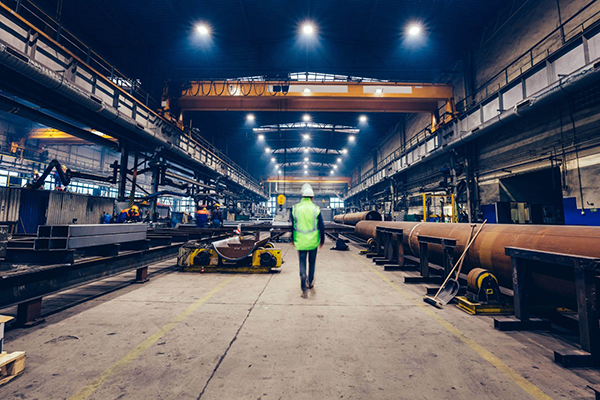Reshoring offers manufacturers a suite of advantages aligning with the complexities and shifts characterizing current business environments.
by: Brian Legan, EY Americas Industrial Products Leader
A transformation is underway in manufacturing, as the shift to reshoring will reshape the industry’s landscape. Historically, US companies have relied on manufacturing operations in low-cost countries, but the war in Ukraine, trade tensions, rising wages and supply chain disruptions have pushed American businesses to consider reshoring. The Biden administration is urging the country to create resilient, diverse and secure supply chains to ensure economic prosperity and national security. There’s opportunity to institute lasting change, but there are multiple layers affecting manufacturers that we must consider.
As companies adapt to changing dynamics, it is becoming a necessity to shift their logistics, inventory management and warehousing strategies to respond to broader economic shifts. Reshoring enhances that adaptability and allows companies to mitigate the impact of rising costs and maintain competitiveness in a dynamic market environment.
Reliance on semiconductors and growing investments in electric vehicles prompted the US to prioritize domestic production, reducing dependence on foreign manufacturers and suppliers to safeguard national security interests. This intricate web of geopolitical factors is reshaping the landscape, influencing economic strategies and security considerations on a global scale.
Not to mention, the US is experiencing unprecedented levels of federal incentives. Laws such as the Infrastructure Investment and Jobs Act (IIJA), the Innovation and Research Act (IRA) and the CHIPS and Science Act will inject around $1.6 trillion over a five-year span, fostering a surge in new manufacturing construction. But there are challenges for companies looking to bring manufacturing back to the US. According to the National Association of Manufacturers (NAM), there is an increase in federal regulations with more than 30 federal agencies introducing over 100 new regulations.
These regulations address concerns but also impose additional costs on manufacturers, adding complexity to a landscape that seeks to balance economic growth, environmental considerations and regulatory compliance. Given these factors, a lens focused on the long-term implications is critical and manufacturers should not be deterred by near-term regulatory challenges – investing now will create opportunity later.
Manufacturers are turning to domestic production while embracing innovative technologies such as artificial intelligence (AI) to modernize operations, build resilience and mitigate labor shortages. Reshoring and investments in new factory construction have created over 400,000 jobs1, yet many remain unfilled. According to the NAM2, the manufacturing skills gap in the US could result in 2.1 million unfilled jobs by 2030.
The Manufacturing Leadership Council’s survey report on the future of industrial AI in manufacturing3 revealed that many manufacturers may just be starting to leverage the possibilities of AI but are looking to accelerate adoption in the years ahead, with 96% of companies indicating they plan to increase investments in AI. Furthermore, almost one-quarter are applying AI to deliver improvements in supply chain, logistics and quality management.
AI’s ability to process and analyze vast amounts of data in real time opens the door to transformative quality control measures, including forecasting demand more accurately and identifying potential disruptions. Manufacturers are also exploring AI to optimize inventory levels and streamline logistics operations to deliver improved return on invested capital (ROIC), greater cost-efficiency, reduced waste and more.
In embracing AI, manufacturers are redefining operations, revitalizing their roles in local economies and reshaping the future of manufacturing, creating a blueprint for success rooted in innovation and adaptability in a global marketplace.

With the reshoring trend accelerating rapidly, it is shaping C-suite leaders’ views on supply chains and growth strategies. A recent study4 of C-suite executives found that US CEOs are accelerating efforts to shorten supply chains and plans to reshore or nearshore are up 1,000% vs. before the pandemic.
Further, the study revealed that 90% of companies are moving part of their production out of China or have plans to, with 80% considering some reshoring to the US. Meanwhile investment in US-based production is evidenced in the construction of new manufacturing facilities increasing by 116% year over year.
Another recent survey shows that more than half of American CEOs (55%) have plans to reshore their operations – and nearly all of those CEOs (95%) said they would do so in the short term.
In looking to the future, it’s important to reflect on how we got here. The interconnectedness of the global economy and liberalization of international trade facilitated the movement of goods and services across borders. Trade agreements and policies made it easier for companies to establish operations in foreign countries and import products back into the US market. By establishing production facilities in those markets, companies could tailor products to local preferences, circumvent tariffs and import restrictions and gain a competitive advantage. All the while, lower production costs in developing countries, particularly Asia, were a driver of offshoring manufacturing.
But today, inflationary pressures and escalating costs of raw materials and energy are prompting manufacturers to reassess their logistics, inventory management and warehousing strategies. Localized production through reshoring can reduce lead times, enabling manufacturers to more quickly respond to shifts in market demand and adjust production. The combination of supply chain resilience, quality control, changing cost dynamics, technological advancements and shifting consumer preferences has led to the resurgence of reshoring in manufacturing.
And as companies continue to further automate their operations, we can expect to see reshoring becoming a bigger priority for the C-suite. While not a one-size-fits-all solution, reshoring offers manufacturers a range of benefits that align with today’s complex and rapidly changing business landscape.
The views reflected in this article are the views of the author and do not necessarily reflect the views of Ernst & Young LLP or other members of the global EY organization.

Brian Legan is the Americas Industrial Products Leader in the Advanced Manufacturing & Mobility sector. He works to help his clients make wise technology and business investments to deliver strong financial results, enhance shareholder value and improve market competitiveness. Brian is known for building loyal, multidisciplinary and high-performing teams to serve clients across a variety of market segments, including high technology, automotive, industrial/ manufacturing, aerospace and defense, transportation, critical infrastructure, and energy and environment.
1 https://reshorenow.org/content/pdf/2023_Q1_data_report.pdf
2 https://nam.org/2-1-million-manufacturing-jobs-could-go-unfilled-by-2030-13743/?stream=workforce
3 https://www.manufacturingleadershipcouncil.com/wp-content/uploads/2023/06/The-Future-Of-AI-In-Manufacturing-MLC-2023.pdf
4 https://www.industrialheating.com/articles/97254-the-reshoring-trend-is-rapidly-accelerating
In this episode, I sat down with Beejan Giga, Director | Partner and Caleb Emerson, Senior Results Manager at Carpedia International. We discussed the insights behind their recent Industry Today article, “Thinking Three Moves Ahead” and together we explored how manufacturers can plan more strategically, align with their suppliers, and build the operational discipline needed to support intentional, sustainable growth. It was a conversation packed with practical perspectives on navigating a fast-changing industry landscape.